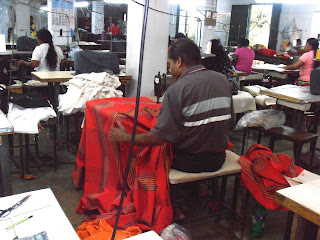After a delicious rice and curry buffet on the verandah of the Capri Club, once again as guests of Andrea’s husband Rudi, we boarded the bus to sit in interminable Colombo traffic for visits to artists across town.
Marie Gnanaraj
Marie lives in a cleverly designed townhouse that incorporates her studio on a mezzanine level. After training with Barbara Sansoni, she became Barefoot’s principal designer in handlooms and one of the country’s most experienced textile artists. She has evolved an art practice in her home studio that demonstrates an engagement with the intrinsic properties of fibres like coir rope (manufactured from the coconut husk) to create textured works. Her experimental work incorporates found objects like bobbins and shuttles to create visual interest.
Her elegant, rectilinear designs glow in earth tones. She had mounted a display of beautiful work, subtle gradations of colour and texture that appeared as painted washes. Indeed, Marie states that she develops her weavings as though they are paintings, the delicacy of the tonal shifts made concrete by the twisted properties of the yarn. In her studio her assistant works diligently, skillfully carrying out Marie’s latest experimental ideas.
Marie and her display of work
Marie's assistant working on one of her designs
Tilak Samarawickrama
We travelled a short distance away to Ascot Avenue where the esteemed artist, architect and designer recognised by his first name, Tilak, lives. The small house and studio that he designed is immaculately arranged with an eye to economy of space and function, clearly inspired by his training.
The walls are decorated with several of his trademark wall hangings and spectacular floor to ceiling wire sculptures of characters derived from his sensitive line drawings of stilt walkers. Based on the Sinhala script, his graphics are sensuously curvaceous and brought him early recognition in Europe for his unique style.
Tilak in front of his wire sculpture
Tapestry design featured on the cover of latest publication
Also a maker of animations, his recent celebration of World Cup Cricket for a biscuit company makes entertaining viewing.



















.jpg)
























